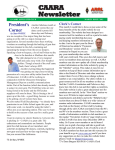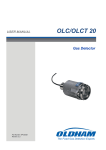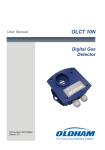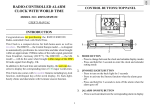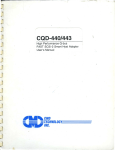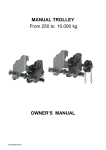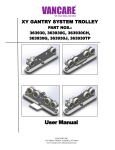Download manual trolley ex instruction manual rptc 10000
Transcript
MANUAL TROLLEY EX INSTRUCTION MANUAL RPTC 10000 English STD-R-KHA-F-CQD-ENG This document and the information contained herein, is the exclusive property of R&M Materials Handling, Inc., and represents a non-public, confidential and proprietary trade secret that may not be reproduced, disclosed to third parties, altered or otherwise employed in any manner whatsoever without the express written consent of R&M Materials Handling, Inc. Copyright © (2010) R&M Materials Handling, Inc. All rights reserved. RPTC 10000 MANUAL/EN/07.30.10 m m CAUTION: Read the instructions supplied with the product before installation and commissioning. CAUTION: Keep the instructions in a safe place for future reference. TABLE OF CONTENTS 1 INTRODUCTION ........................................................................................................................................ 3 1.1 Foreword ............................................................................................................................................. 4 1.2 Warranty .............................................................................................................................................. 4 1.3 Minimum charges ................................................................................................................................ 4 1.4 Claims for damage in shipment........................................................................................................... 4 2 MANUAL TROLLEYS ................................................................................................................................ 5 2.1 What not to do ..................................................................................................................................... 5 2.2 What to do ........................................................................................................................................... 5 2.3 General information ............................................................................................................................. 6 2.3.1 Acceptance of the material .......................................................................................................... 6 2.3.2 Installation .................................................................................................................................... 6 2.4 Presentation ........................................................................................................................................ 8 2.4.1 Brief description of manual gantry crab ....................................................................................... 8 2.4.2 Characteristics and dimensions ................................................................................................... 8 2.5 Setting of the axle "no rock" .............................................................................................................. 12 2.6 Adjustment of the flanges .................................................................................................................. 13 2.7 Assembly on the track ....................................................................................................................... 15 3 APPLICABLE DIRECTIVES FROM JULY 1, 2003 ................................................................................. 16 3.1 Hazardous area classifications ......................................................................................................... 16 3.2 Gas group and temperature classes ................................................................................................. 16 3.3 ATEX label: ....................................................................................................................................... 17 3.4 Conformity to the ATEX Directive: .................................................................................................... 17 3.5 Gas hazard area marking: ................................................................................................................. 18 3.6 Dust hazard area marking: ................................................................................................................ 18 3.7 Technical installation and maintenance ............................................................................................ 19 3.7.1 Qualifications of installation & maintenance personnel ............................................................. 19 3.7.2 General maintenance ................................................................................................................. 19 2/19 This document and the information contained herein, is the exclusive property of R&M Materials Handling, Inc., and represents a non-public, confidential and proprietary trade secret that may not be reproduced, disclosed to third parties, altered or otherwise employed in any manner whatsoever without the express written consent of R&M Materials Handling, Inc. Copyright © (2010) R&M Materials Handling, Inc. All rights reserved. RPTC 10000 MANUAL/EN/07.30.10 1 INTRODUCTION m m CAUTION: Read the instructions supplied with the product before installation and commissioning. CAUTION: Keep the instructions in a safe place for future reference. Before proceeding with the operation or maintenance of the equipment it is important that the operating and maintenance personnel read this bulletin carefully in order to ensure the safe and efficient use of the equipment. Also, it is strongly recommended that the personnel responsible for the operation, inspection, and servicing of this hoist, read and follow the Safety Standard ASME B30.16-1998 (or current revised edition). This standard covers Overhead Hoists (under-hung) as promulgated by the American National Standards Institute and is published by the American Society of Mechanical Engineers. Copies of this publication are available from the Society at United Engineering Center, 345 East 47th St., New York, NY 10017. If any instructions are unclear, contact the manufacturer or distributor of the equipment before attempting to install or use the hoist. R&M Materials Handling Inc 4501 Gateway Boulevard Springfield, OH 45502 General Telephone: 937 - 328-5100 Toll Free Telephone (US): 800 - 955-9967 General Fax: 937 - 325-5319 3/19 This document and the information contained herein, is the exclusive property of R&M Materials Handling, Inc., and represents a non-public, confidential and proprietary trade secret that may not be reproduced, disclosed to third parties, altered or otherwise employed in any manner whatsoever without the express written consent of R&M Materials Handling, Inc. Copyright © (2010) R&M Materials Handling, Inc. All rights reserved. RPTC 10000 MANUAL/EN/07.30.10 1.1 Foreword This manual has been prepared to acquaint you of the procedures necessary for the installation, operation and maintenance of the equipment you have purchased. Proper use is important to the ultimate performance of this equipment. Careful study of and adherence to the instructions will help ensure safe, dependable operation. It is also recommended that you keep this manual readily accessible to operators as well as maintenance and safety personnel. Information in this manual is subject to change without notice. 1.2 Warranty All sales are subject to the R&M Standard Terms and Conditions of Sale and Product Warranty. Copies are available upon request from R&M and are expressly incorporated by reference hereto. 1.3 Minimum charges All orders for repair parts are subject to a minimum charge. 1.4 Claims for damage in shipment All shipments are carefully inspected and are delivered to the carrier in good order. Upon receipt of shipment caution should be exercised so that there is no loss or damage. If damage has occurred, refuse to accept the shipment until the carrier makes the proper notation to that effect. In the event of concealed loss or damage, notify the carrier immediately. By following these suggestions you will encounter less difficulty collecting your claim. 4/19 This document and the information contained herein, is the exclusive property of R&M Materials Handling, Inc., and represents a non-public, confidential and proprietary trade secret that may not be reproduced, disclosed to third parties, altered or otherwise employed in any manner whatsoever without the express written consent of R&M Materials Handling, Inc. Copyright © (2010) R&M Materials Handling, Inc. All rights reserved. RPTC 10000 MANUAL/EN/07.30.10 2 MANUAL TROLLEYS 2.1 2.2 What not to do Do not set down the machine without having an adapted support to avoid damaging the sensitive sides. Do not let the machine drop. Never modify the machine unless the constructor has studied and authorized the modification. Never modify the values and adjustments of the safety components, outside the limits provided for in the manual, or without the approval of the constructor. Never try to repair or alter the machine (e.g., welding) without the authorization of the constructor or a trained maintenance agent. Do not let an unqualified person use the machine. Never lift more than the maximum working load indicated on the machine. Shocks or accidental collision of the load with objects can cause excess loads. Never remove the hook safety catches. Never use the machine to extract, loosen, or pull sideways. Never use the machine to transport people. Do not touch the moving components. Do not operate the machine if your physical condition does not allow it. Never use the machine when in bad repair (wear, deformation, etc.). Never use suspect spare parts or parts whose origin is not known. Never swing the load intentionally. Do not subject the machine to brutal shocks. Do not use the mechanical stops as a repetitive means of stopping. Never distract the operator while the machine is being operated. Never leave a suspended load hanging, unless necessary. Do not use the machine for a purpose or in an area for which it is not intended. Do not expose the machine to an aggressive atmosphere (temperature, acidity, etc.). Do not use the safety components as operation components. Do not use the controls needlessly (avoid inching, operating the buttons in a stop-start manner). This can cause overheating and even damage to the machine. Never pull the load slantwise. Make sure that the machine is vertical to the load before lifting. Never transport a load with people nearby. Do not pass the machine, with or without a load, above a person. What to do Handle the machine by its structure, or by the devices provided for this purpose, or in its original packing. Store the machine in its normal operating position (without load) away from aggressive atmospheres (dust, humidity, etc.). Make sure that the machine is always clean and protected from corrosion (lubrication, etc.). The machine should be installed by a technician with the competence required. Ensure the machine attaching structure is rigid. Ensure that safety rules are followed (harness, clearance of work areas, posting of instructions to be followed in the area, etc.). Use the trolley between –10°C and + 50°C. Comply with the distance between the trolley and the raceway. Connect the feed cable directly to the supply terminal board in the electric box. Set up an inspection program and record all maintenance operations for the machines, particularly the brake, limit switches, fastening beam, etc. Replace any element that is worn or may be defective. The machine should be maintained regularly in accordance with the instructions in this manual. Check the operation and adjustment of safety components (brake, travel limit, etc.) in conformity with the user manual. Regularly check the machine. If a deformation or unusual wear is noted, the parts must be changed. 5/19 This document and the information contained herein, is the exclusive property of R&M Materials Handling, Inc., and represents a non-public, confidential and proprietary trade secret that may not be reproduced, disclosed to third parties, altered or otherwise employed in any manner whatsoever without the express written consent of R&M Materials Handling, Inc. Copyright © (2010) R&M Materials Handling, Inc. All rights reserved. RPTC 10000 MANUAL/EN/07.30.10 2.3 Check that the assembly elements are correctly tightened. Check that the steel cable strands supporting the control box fulfill their functions properly. The components should only be replaced by original parts that are compatible with the type of machine. Before operation, ensure that the load is correctly fastened and installed. Make sure the load is correctly balanced before moving it. Pay attention to the center of gravity of the load to be moved. When moving the load, make sure it is sufficiently raised and distant from the surrounding machines and other objects so as to avoid all obstacles during operation, ask for help if the volume of the load prevents you from seeing above it. Use the standards of ergonomics to use the trolley. If manually moving the machine, push the load. The prevention instructions to be carried out during different operations should be well known. Use the material under normal working conditions (ambient temperature, atmosphere, etc.). Material used outdoors should be protected as well as possible against bad weather conditions. Notify the necessary people after a dangerous operation or if the machine seems problematic (abnormal noise, abnormal behavior, etc.). General information 2.3.1 Acceptance of the material Carry out a visual inspection of the packing to ensure it is intact. If the package is not intact, issue the appropriate notifications. Check that the trolley corresponds to your order. 2.3.2 Installation The service life of a trolley depends upon how it is installed. It is essential that the instructions in this manual are followed carefully for the installation, use, and maintenance of the machine. Any use contrary to the instructions may be dangerous. In this case, the manufacturer will not accept any liability. Do not use the machine without having read and understood the whole of the instruction manual. Always keep the manual close to the machine, available to the operator and to the person responsible for maintenance. Make sure safety rules are followed (harness, clearance of work area, posting of instructions to be followed in the work area, etc.). The trolley can be adapted to all runaway profiles. Couple or hook on the hoist after installation of the trolley. m CAUTION: Check the width of the runaway rail and adapt the spacing of the flanges of the trolley as indicated in the tables Ensure: That the profile is secured. That the profile is suitable to the loads to be supported. That the dimensions are compatible with the trolley which is to be installed. That the maximal deflection of the profile does not exceed 1/500 of the span under the dead loads and the SWL. That the longitudinal slope of the track does not exceed 0.3 %. 6/19 This document and the information contained herein, is the exclusive property of R&M Materials Handling, Inc., and represents a non-public, confidential and proprietary trade secret that may not be reproduced, disclosed to third parties, altered or otherwise employed in any manner whatsoever without the express written consent of R&M Materials Handling, Inc. Copyright © (2010) R&M Materials Handling, Inc. All rights reserved. RPTC 10000 MANUAL/EN/07.30.10 Carry out: 1. Disassembly of the trolley Remove the side plate on the counterweight side. Position the trolley on the beam. Refit the side plate. Ensure that all nuts are correctly tightened. 2. Without disassembly of the trolley Install the trolley on the profile, by the end. Fit the travel limit stops (not provided) at the end of the runway. Ensure that all nuts are correctly tightened. On the curved profiles, the driving wheels should be positioned on the outside of the curve, preferably. These points have to be checked after a repair, a maintenance operation or a long stop. Curve radius: 250 kg / 500 kg = 1m 1000 kg = 1.5 m 2000 kg / 3000 kg = 2m 5000 kg = 3m NOTE: Coupling part center must be located in the center of the beam. Figure 1. Chain travel trolley NOTE: VERY IMPORTANT! See side plate setting table. 7/19 This document and the information contained herein, is the exclusive property of R&M Materials Handling, Inc., and represents a non-public, confidential and proprietary trade secret that may not be reproduced, disclosed to third parties, altered or otherwise employed in any manner whatsoever without the express written consent of R&M Materials Handling, Inc. Copyright © (2010) R&M Materials Handling, Inc. All rights reserved. RPTC 10000 MANUAL/EN/07.30.10 2.4 Presentation The manual gantry crabs make it possible to suspend any type of lifting equipment provided with a hook, lifting loads of 250 to 10,000 kg. 2.4.1 Brief description of manual gantry crab The crab is comprised of: 2 flanges, in sheet steel 4 rollers mounted on ball bearings with detachable axles and rolling rims profiled to roll on any type of iron monorail 1 cross-bar for hook or coupling, in steel, to ensure the bracing of the assembly. 2.4.2 Characteristics and dimensions Push travel trolley Figure 2. Push travel trolley characteristics and dimensions 8/19 This document and the information contained herein, is the exclusive property of R&M Materials Handling, Inc., and represents a non-public, confidential and proprietary trade secret that may not be reproduced, disclosed to third parties, altered or otherwise employed in any manner whatsoever without the express written consent of R&M Materials Handling, Inc. Copyright © (2010) R&M Materials Handling, Inc. All rights reserved. RPTC 10000 MANUAL/EN/07.30.10 Table 1. Push travel trolley characteristics and dimensions Capacity [kg] 250 500 ─ 1000 ─ 2000 ─ 3000 ─ 5000 ─ 6300 ─ 7500 ─ 10000 ─ 12500 ─ 16000 ─ 20000 ─ Beam width [mm] 50 - 202 50 - 200 188 - 310 65 - 202 188 - 310 88 - 202 188 - 310 100 - 202 188 - 310 114 - 202 188 - 310 124 - 202 188 - 310 124 - 202 188 - 310 124 - 202 188 - 310 124 - 202 188 - 310 136 - 202 188 - 310 136 - 202 188 - 310 A [mm] 284 303 411 326 425 340 448 356 464 375 484 394 502 394 502 400 506 408 514 472 578 472 578 B [mm] 16 19 19 22 22 26 26 28 28 34 34 43 43 43 43 46 46 48 48 75 75 75 75 C [mm] 32 32 32 39 39 42 42 49 49 60 60 68 68 68 68 70 70 70 70 92 92 88 88 ØD [mm] 74 79 79 92 92 104 104 131 131 144 144 170 170 170 170 176 176 176 176 226 226 226 226 E [mm] 60 62 62 82 82 98 98 146 146 161 161 175 175 175 175 187 187 185 185 283 283 277 277 F [mm] 13 19 19 22 22 24 24 27 27 36 36 39 39 39 39 40 40 41 41 54 54 54 54 G [mm] 170 185 185 225 225 272 272 322 322 362 362 411 411 411 411 442 442 442 442 555 555 555 555 H [mm] 80 85 85 101 101 124 124 145 145 158 158 185 185 185 185 200 200 200 200 272 272 272 272 J [mm] 194 210 210 249 249 296 296 346 346 386 386 436 436 436 436 466 466 466 466 579 579 579 579 ØK [mm] 18 24 24 28 28 36 36 44 44 48 48 50 50 50 50 50 50 50 50 50 50 50 50 ØM [mm] 15 20 20 22 22 28 28 28 28 35 35 43 43 43 43 45 45 50 50 64 64 68 68 ØN [mm] 50 55 55 62 62 76 76 96 96 108 108 130 130 130 130 134 134 134 134 168 168 175 175 Chain travel trolley Figure 3. Chain travel trolley characteristics and dimensions 9/19 This document and the information contained herein, is the exclusive property of R&M Materials Handling, Inc., and represents a non-public, confidential and proprietary trade secret that may not be reproduced, disclosed to third parties, altered or otherwise employed in any manner whatsoever without the express written consent of R&M Materials Handling, Inc. Copyright © (2010) R&M Materials Handling, Inc. All rights reserved. RPTC 10000 MANUAL/EN/07.30.10 Table 2. Chain travel trolley characteristics and dimensions A B C ØD E F G H J ØK ØM ØN P Q S U [kg] Beam width [mm] [mm] [mm] [mm] [mm] [mm] [mm] [mm] [mm] [mm] [mm] [mm] [mm] [mm] [mm] [mm] [mm] 1000 65 - 202 326 22 39 92 82 22 225 101 249 28 22 62 146 76 40 160 188 - 310 425 22 39 92 82 22 225 101 249 28 22 62 146 76 40 160 Capacity 2000 3000 5000 6300 7500 10000 12500 16000 20000 88 - 202 340 26 42 104 98 24 272 124 296 36 28 76 146 92 38 157 188 - 310 448 26 42 104 98 24 272 124 296 36 28 76 146 92 38 157 100 - 202 310 28 49 131 146 27 322 145 346 44 28 96 37.5 114 38 58 188 - 310 418 28 49 131 146 27 322 145 346 44 28 96 37.5 114 38 58 114 - 202 326 34 60 144 161 36 362 158 386 48 35 108 37.5 126 47 60 188 - 310 434 34 60 144 161 36 362 158 386 48 35 108 37.5 126 47 60 124 - 202 344 43 68 170 175 39 411 185 436 50 43 130 80 154 46 68 188 - 310 452 43 68 170 175 39 411 185 436 50 43 130 80 154 46 68 124 - 202 344 43 68 170 175 39 411 185 436 50 43 130 80 154 46 68 188 - 310 452 43 68 170 175 39 411 185 436 50 43 130 80 154 46 68 68 124 - 202 350 46 70 176 187 40 442 200 466 50 45 134 80 154 46 188 - 310 458 46 70 176 187 40 442 200 466 50 45 134 80 154 46 68 124 - 202 358 48 70 176 185 41 442 200 466 50 50 134 59 154 45 65 188 - 310 466 48 70 176 185 41 442 200 466 50 50 134 59 154 45 65 136 - 202 416 75 92 226 283 54 555 272 579 50 64 168 73 197 78 78 188 - 310 522 75 92 226 283 54 555 272 579 50 64 168 73 197 78 78 136 - 202 416 75 88 226 277 54 555 272 579 50 68 175 73 120 60 78 188 - 310 522 75 88 226 277 54 555 272 579 50 68 175 73 120 60 78 10/19 This document and the information contained herein, is the exclusive property of R&M Materials Handling, Inc., and represents a non-public, confidential and proprietary trade secret that may not be reproduced, disclosed to third parties, altered or otherwise employed in any manner whatsoever without the express written consent of R&M Materials Handling, Inc. Copyright © (2010) R&M Materials Handling, Inc. All rights reserved. RPTC 10000 MANUAL/EN/07.30.10 Figure 4. Hand chain length to unwind in order to move the load or the trolley over a distance of 1 m. Load [kg] Chain length [m] 1000 1500 2000 3000 5000 6300 7500 10000 12500 16000 20000 3.4 3.4 3.4 4.5 4.5 5 5 5 5 9.5 9.1 Table 3. Wheel and handling chain capacities Capacity [kg] wheel diameter [mm] handling chain [mm x mm x mm] 1000 115 5 x 23.7 x 18 115 5 x 23.7 x 18 2000 115 5 x 23.7 x 18 115 5 x 23.7 x 18 3000 160 5 x 23.7 x 18 160 5 x 23.7 x 18 5000 160 5 x 23.7 x 18 160 5 x 23.7 x 18 6300 160 5 x 23.7 x 18 160 5 x 23.7 x 18 160 5 x 23.7 x 18 160 5 x 23.7 x 18 160 5 x 23.7 x 18 160 5 x 23.7 x 18 7500 10000 12500 16000 20000 160 5 x 23.7 x 18 160 5 x 23.7 x 18 160 5 x 23.7 x 18 160 5 x 23.7 x 18 160 5 x 23.7 x 18 160 5 x 23.7 x 18 11/19 This document and the information contained herein, is the exclusive property of R&M Materials Handling, Inc., and represents a non-public, confidential and proprietary trade secret that may not be reproduced, disclosed to third parties, altered or otherwise employed in any manner whatsoever without the express written consent of R&M Materials Handling, Inc. Copyright © (2010) R&M Materials Handling, Inc. All rights reserved. RPTC 10000 MANUAL/EN/07.30.10 2.5 Setting of the axle "no rock" Chain travel trolley 1000 kg (beam : 65 à 310), 2000 kg (beam : 88 à 310) Figure 5. Axle setting dimension This adjustment must be done when the trolley is put in place. The dimension "H" between the lower face of the beam and the upper line of the axle is 1 mm. This value may be adjusted to achieve best operation. 12/19 This document and the information contained herein, is the exclusive property of R&M Materials Handling, Inc., and represents a non-public, confidential and proprietary trade secret that may not be reproduced, disclosed to third parties, altered or otherwise employed in any manner whatsoever without the express written consent of R&M Materials Handling, Inc. Copyright © (2010) R&M Materials Handling, Inc. All rights reserved. RPTC 10000 MANUAL/EN/07.30.10 2.6 Adjustment of the flanges Trolley adjustment Figure 6. Chain travel trolley Figure 7. Chain travel trolley components The trolley can be adjusted to accommodate different track widths using the following procedure: 1. Check width B of the track (Figure 7). 2. The distance B’ between the wheel flanges can be adjusted using the spacers (1) and washers (2). Make sure that the suspension pin (3) is centered on the track. Depending on the tolerances of the washers and spacers, the stacking can be different on the left side and on the right side (Figures 6 and 7). 3. In any case, provide at least one washer outside the flange (4), under the nut (5) (Figure 6)! 4. After adjustment, tighten the nuts (5) and reinsert the pins (6) (Figure 6). 13/19 This document and the information contained herein, is the exclusive property of R&M Materials Handling, Inc., and represents a non-public, confidential and proprietary trade secret that may not be reproduced, disclosed to third parties, altered or otherwise employed in any manner whatsoever without the express written consent of R&M Materials Handling, Inc. Copyright © (2010) R&M Materials Handling, Inc. All rights reserved. RPTC 10000 MANUAL/EN/07.30.10 m Caution: When adjusting dimension B’ between the rollers, add the track width: • For trolleys up to 2000 kg, add up to 3 mm C • For trolleys in excess of 3000 kg, add from 3 to 5 mm C The values above are for guidance only. Clearance depends upon the tolerance and quality of the track. Figure 8. Chain travel trolley track adjustment dimensions 14/19 This document and the information contained herein, is the exclusive property of R&M Materials Handling, Inc., and represents a non-public, confidential and proprietary trade secret that may not be reproduced, disclosed to third parties, altered or otherwise employed in any manner whatsoever without the express written consent of R&M Materials Handling, Inc. Copyright © (2010) R&M Materials Handling, Inc. All rights reserved. RPTC 10000 MANUAL/EN/07.30.10 2.7 Assembly on the track At this stage, the distance between the wheel flanges is set. The trolley can be introduced through either end of the hoist track. If this is not possible—for instance, if the mechanical stops or limit switches are already in place—the trolley can also be installed through the lower flanges. In this case, remove the nuts on one side of the trolley and move the flanges apart. Reassemble all components and ensure that dimension C is correct (Figure 7). Figure 9. Flanges being moved apart Figure 10. Flanges being moved apart m Ensure that the suspension pin (3) is centered on the track (Figure 6). 15/19 This document and the information contained herein, is the exclusive property of R&M Materials Handling, Inc., and represents a non-public, confidential and proprietary trade secret that may not be reproduced, disclosed to third parties, altered or otherwise employed in any manner whatsoever without the express written consent of R&M Materials Handling, Inc. Copyright © (2010) R&M Materials Handling, Inc. All rights reserved. RPTC 10000 MANUAL/EN/07.30.10 3 APPLICABLE DIRECTIVES FROM JULY 1, 2003 Manufacturer : ATEX 94/09/EC or ATEX 100a User (installation) : ATEX 99/92/EC or ATEX 137a (England) or 118a (France) 3.1 Hazardous area classifications Table 4. Hazardous area classification Classification Group 1 (mines) Classification Group 2 (surface) Equipment category Flammable substances Comparison M1 Methane, dust Group 1 M2 Methane, dust Group 1 1 Gases, vapors, fog, dust 2 Gases, vapors, fog, dust 3 Gases, vapors, fog, dust Group 2 Z 0 (gases) / Z 20 (dust) Group 2 Z 1 (gases) / Z 21 (dust) Group 2 Z 2 (gases) / Z 22 (dust) Table 5. Explosive atmosphere presence by hazard area classification Category Presence of explosive atmosphere (per year) 3.2 1 2 Constant or for long periods Probable during normal operation (occasional) > 1000 hrs 3 Rarely or for short periods Safe area Practically never < 10 hrs 10 <…< 1000 hrs Gas group and temperature classes Table 6. Gas group and temperature classes Max. surface temperature T1 - 450° C T2 - 300° C T3 - 200° C T4 - 135° C T5 - 100° C T6 - 85° C II A Methane Monoxyde carbone Ammoniac Acetone Toluene Propane Butane Gas Acetaldehyde ─ ─ Gas group II B IIC Cyclopropane Acide cyanhydrique Hydrogene Ethylene Butadiene ─ Diethyl ether ─ ─ Acetylene ─ ─ ─ ─ 16/19 This document and the information contained herein, is the exclusive property of R&M Materials Handling, Inc., and represents a non-public, confidential and proprietary trade secret that may not be reproduced, disclosed to third parties, altered or otherwise employed in any manner whatsoever without the express written consent of R&M Materials Handling, Inc. Copyright © (2010) R&M Materials Handling, Inc. All rights reserved. RPTC 10000 MANUAL/EN/07.30.10 3.3 ATEX label: The following label identifies ATEX equipment suitable for the hazardous area defined by the specific marking: Figure 11. ATEX label II 2 G c IIC T4 INERIS FILE NBR : 20372 / 08 AMBIENT TEMPERATURE -20°C … +50°C PLEASE REFER TO THE INSTRUCTIONS According to ATEX Directive 99/92/EC, it is the user’s responsibility to verify the suitability of the ATEX equipment to the hazardous area. 3.4 Conformity to the ATEX Directive: INERIS, notified body and identified under number 0080, in accordance with article 9 of Council Directive rd 94/9/EC of the 23 of March 1994, has acknowledged receipt of our technical file according to the procedure described in article 8 b) ii) of the directive. The technical documentation has been consigned by the INERIS notified body under the reference: 20372/08 17/19 This document and the information contained herein, is the exclusive property of R&M Materials Handling, Inc., and represents a non-public, confidential and proprietary trade secret that may not be reproduced, disclosed to third parties, altered or otherwise employed in any manner whatsoever without the express written consent of R&M Materials Handling, Inc. Copyright © (2010) R&M Materials Handling, Inc. All rights reserved. RPTC 10000 MANUAL/EN/07.30.10 3.5 Gas hazard area marking: Ex II 2 G c IIC T4 EX: Utilization in hazardous area II: Surface equipment 2: Category 2 G: Gas hazard area c: Protection type* IIC: Gas group T4: Temperature class 3.6 Dust hazard area marking: Ex II 2 D c T+135°C EX: Utilization in hazardous area II: Surface equipment 2: Category 2 D: Dust hazard area c: Protection type* T+135°C: Maximum surface temperature *‘c’ in the marking means "Constructional safety" Constructional safety is a protection mode stating that the mechanical design of the hoist has been made according to standards to avoid any spark generation in normal operation and in regular maintenance of the equipment. 18/19 This document and the information contained herein, is the exclusive property of R&M Materials Handling, Inc., and represents a non-public, confidential and proprietary trade secret that may not be reproduced, disclosed to third parties, altered or otherwise employed in any manner whatsoever without the express written consent of R&M Materials Handling, Inc. Copyright © (2010) R&M Materials Handling, Inc. All rights reserved. RPTC 10000 MANUAL/EN/07.30.10 3.7 Technical installation and maintenance 3.7.1 Qualifications of installation & maintenance personnel Only persons whose training includes instruction on the various types of protection involved, including appropriate, periodic refresher training, should carry out installation and maintenance. 3.7.2 General maintenance Repairs on Ex equipment are classified into two types: Work on equipment in the hazardous area. Work on equipment that can be removed from the hazardous area Work in the hazardous area The following must be clarified with the operator before starting work in the hazardous area: Is there an explosion hazard in the working area? Is there a poison hazard? What visual and acoustic signals apply in case of danger? Are there escape routes and how are they marked? How is the equipment isolated from the mains supply and secured (warning sign and padlock)? What hazard zone is present: in the vicinity of the Ex equipment? in the vicinity of the control equipment (on the ground for cranes)? The customer is responsible for the use and safety of the installation during operation. Consequently, they alone are qualified to answer the questions above in sufficient detail and, thus, determine whether work can be carried out without risk. Typically, the customer will issue a “hot work” permit in which the operator informs the technician that he may work on the Ex installation and specifies the times when he may do so. This written permit is primarily required for welding and other works that may cause a hazard (e.g., grinding), but also applies when auxiliary equipment, such as a power drill, is used. After the work—not including maintenance work—has been completed, the customer may demand an installation certificate. The technician assumes significant responsibility for this work because the customer is not obligated to have the electrical installation inspected further by an Ex expert before commissioning. Modifications to Ex equipment affecting Ex protection may not be performed by the technician. If such modifications are necessary, the equipment or the installation must be inspected by an Ex expert. The acceptance test is confirmed by an expert's report. If you are uncertain about any issues that may arise during a repair, always seek guidance from your senior manager or local specialist. If you are forced by a customer for reasons of urgency to perform a modification or installation that does not comply with regulations, please ensure that the customer signs a certificate with the following wording: "The modification on equipment __________was ordered by me_________for operational reasons, despite the technician’s indication that the condition of the equipment no longer complies with regulations. It was pointed out that the equipment must be returned to a serviceable condition as soon as possible." Work outside the hazardous area If practical, equipment should be moved to a safe area before commencing work. If such relocation is possible, observe all safety precautions when dismantling and transporting the equipment. This includes vehicles moving equipment from the hazardous area to a non-hazardous area and vice versa. 19/19 This document and the information contained herein, is the exclusive property of R&M Materials Handling, Inc., and represents a non-public, confidential and proprietary trade secret that may not be reproduced, disclosed to third parties, altered or otherwise employed in any manner whatsoever without the express written consent of R&M Materials Handling, Inc. Copyright © (2010) R&M Materials Handling, Inc. All rights reserved.





















